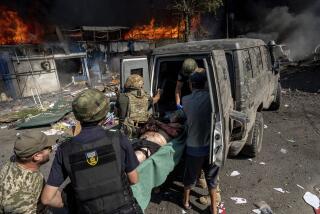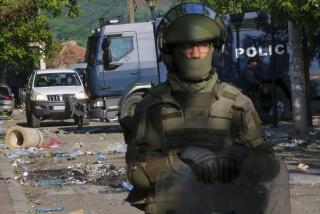A Primer on the Conflict in Kosovo
- Share via
Question: What is Kosovo?
Answer: Kosovo is a province in the republic of Serbia, which, with the smaller republic of Montenegro, makes up what is left of today’s Yugoslavia. Since Slobodan Milosevic rose to power in Serbia 10 years ago, other republics have broken away from the Yugoslav federation and established their independence, some through war, leaving only Serbia and Montenegro.
Unlike the rest of Yugoslavia, Kosovo is made up primarily of ethnic Albanians--about 90% of the province’s approximately 2 million people.
*
Q. What are the Kosovo factions fighting about?
A. The ethnic Albanians want independence and do not want to be ruled by a Serb-dominated government. They regard Kosovo as their homeland, a rugged region of rolling hills, hardscrabble farms and forests.
The Serbs, on the other hand, cherish Kosovo as the cradle of their civilization. It is home to many ancient Serbian Orthodox monasteries and was the site of a battle in 1389 that Serbs consider the defining moment of their culture--a battle that was lost by the Serbs and that opened the way for the Turkish domination of the region. Many Serbs like to see themselves as leading the fight ever since to end Turkish, and Muslim, influence.
Both sides, then, want to control the region. Moreover, Milosevic needs to retain Kosovo because he cannot politically afford to lose more territory. He used the Kosovo cause to rally a virulent wave of Serbian nationalism, rode it to power and continues to rely on it to hold on to power.
Because Albanians refuse to vote in elections, Milosevic easily controls all the parliamentary seats representing Kosovo, giving him and his party an unchallenged majority.
*
Q. What are Albanians doing in Yugoslavia to begin with? Are they immigrants? And if Kosovo is the cradle of Serbian civilization, how did Serbs become such a tiny minority?
A. “Albanian” refers to an ethnic group, one of the oldest in Europe. “Greater Albania” once encompassed a large swath of the southern Balkans. When boundaries of the Balkan countries were drawn earlier this century, many ethnic Albanians were left outside the country that became today’s Albania. They populated what became Serbia.
Over the years, more Albanians arrived in Kosovo to join their relatives. Meanwhile, many Serbs left what was always a desolate, underdeveloped, impoverished region, opting instead for the factories and offices of Nis or Belgrade. Adding to the demographic shift is the birthrate among Albanians, which is one of the highest in the world.
*
Q. How did this conflict start?
A. Relations between Serbs and ethnic Albanians in Kosovo have been tense for decades; whichever group was in charge oppressed the other.
Under communism, Kosovo enjoyed a limited autonomy. Serbs say that Albanians, in the majority, routinely discriminated against Serbs. This became the pretext for Milosevic in 1989 to yank Kosovo’s autonomous status and set in motion a steady hardening of hostilities.
After 1989, with the numbers so lopsided, the situation in Kosovo became apartheid-like. A small minority--Serbs--ruled a large majority, the Albanians.
Serbian police were deployed to control the Albanians, who for the most part began to boycott all state institutions. Teachers, told they could no longer teach in the Albanian language, walked off their jobs; many others were fired. Similar purges took place in hospitals and other sectors.
The Albanians over the years set up their own parallel, if substandard, education and health systems. They began calling their region the Kosovo Republic and their main leader, Ibrahim Rugova, their president. Tensions ran high, and Albanians were frequently arrested or harassed, but a relative peace continued through most of this decade.
*
Q. Why didn’t the people of Kosovo bolt when the rest of Yugoslavia was falling apart, when Croatia and Bosnia-Herzegovina were seceding?
A. Rugova insisted on peaceful resistance and heeded American entreaties that he keep a lid on unrest. Yet once peace was established in Bosnia at the end of 1995, and Bosnian Serbs there were given their own republic, many Kosovo Albanians began to feel left out and betrayed. Their patience ran out, and Rugova began to lose control. A guerrilla army was born.
*
Q. How did the guerrilla army grow?
A. At first the Kosovo Liberation Army, as it became known, struck with very limited attacks on Serbian police and an occasional car bomb. In November 1997, however, it engaged in its first real skirmish with Serbian security forces and within a few months was growing and openly battling Yugoslav police and army. In February 1998, Milosevic unleashed a brutal counteroffensive against the KLA, in which numerous civilians and children were also killed. It was initially a setback for the KLA but ultimately fed more and more recruits into ethnic Albanian armed ranks.
Serbs also dug in. They fear, probably correctly, that if Albanians are given control of Kosovo, there will be no place for Serbs.
*
Q. Why is NATO involved? Why should Americans care about Kosovo?
A. NATO is involved in Kosovo partly because of the potential for violence to spread beyond Yugoslavia’s borders. This could arguably threaten stability in Europe by bringing other countries, including NATO allies Greece and Turkey, into the conflict.
NATO and the U.S. are also worried that a wider war in Yugoslavia would endanger Western policy in Bosnia, where a fragile peace agreement brokered by the U.S. and based on ethnic power-sharing might fall apart.
There are also moral considerations. While the ethnic Albanian KLA has also been guilty of human right abuses, Serbian “ethnic cleansing” campaigns have claimed dozens of innocent lives and sent entire villages fleeing as refugees. Many believe that only NATO power can stop such atrocities.
More to Read
Sign up for Essential California
The most important California stories and recommendations in your inbox every morning.
You may occasionally receive promotional content from the Los Angeles Times.














